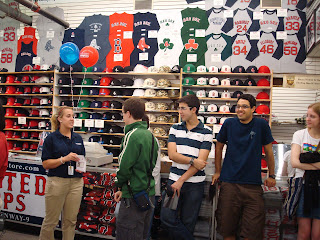
There's one thing that has completely puzzled me during my summer stay here -and I'm not referring to my research. Boston weather is as capricious as weather can get. It's an unruly infant, throwing tantrums here and there when you least expect them. It is usual to have cloudless skies in the mornings and T-storms and hail in the early afternoons. Rain just comes and goes like irregular and unpredictable mood swings. This is why I always have an umbrella at hand, even if it's blazingly sunny outside.
Anyway, the reason I mention weather is that today, during our Fenway Park tour in Boston, the temperature dropped dramatically from the previous hot day, to the point where the skyline was enshrouded in fog by late afternoon. Wind, at first pleasant, blew constantly on the top of the stadium and left some of us squirming from cold.
Scott Kominers, one of our program assistants (PAs), and Justin, a PRISE PA from the past year, led a group of 20 or so of us from the Harvard Square T-station to the Kenmore T-stop and out to the Yawkey Street (a strange phonetic resemblance to the inimical "Yankee"), where Fenway Park is nestled inside a barricade of souvenir shops and eateries. In fact, the stadium is almost hidden from view by the bordering buildings, and only the towering stadium lights hinted at the presence of a stadium beyond the row of stores.
Our tour guide Jessica, a very animated and amusing communicator, took us up, down, and around the stadium for a one-hour-and-a-half tour, which was surprisingly good! I learned a lot of history today about the Fenway Park and the Boston Red Socks. Apparently, the street is named after the Yawkey's, the past owners of Fenway Park who restored the place and saved it from demise. The park was opened in 1912, but its debut was eclipsed by the Titanic disaster that occurred days before. Though it's the third smallest stadium of the Major League Baseball stadium, it is the oldest and the only stadium that has two christened foul poles, the Pesky's Pole and the Fisk Pole.
Jessica took us to the elite cushioned seats in the upper levels that are only reserved to veteran patrons who have payed hundreds of thousands (and even millions) to see Fenway games each year. We also explored the seats above the "Green Monster" (the green wall which also holds the scoreboard) that are prized for their prime location to catch stray baseballs. There is also a single red seat in the midst of all the green seats in the outfield which marks the longest measurable home run hit in Fenway Park.
I'm not going to reveal all the interesting bits the tour guide revealed (such as a fire, an urban legend about the previous owners, and an interesting bar atop the stadium). You just have to visit the park yourself ;)
After our tour, most of us stayed around to have dinner at the Game On! sports bar. For many of those who stayed, this was our first experience in a real sports bar. The inside was extremely nice, with leather sofas, countless plasma TVs, a shrine of shiny drinks, and friendly waitresses. Because he was overage, Scott ordered a nice Harpoon drink, while the rest of us ordered water and sodas, which nicely complemented our sandwiches, fries, hot dogs, etc. The food was great and the price not too overwhelming, though we did end up tipping close to 30% due to the large size of our group. The selection of music was excellent, and as the night progressed, the bar was gradually crowded with a rowdy group of tourists wearing Red Socks 08 shirts.
Before the atmosphere became too crazy and before the 21-limit kicked in, we finished our dinner and headed out back towards the T, with bloated bellies and a headful of new knowledge about the historical Fenway Park.































































